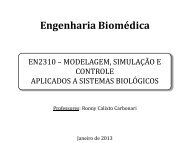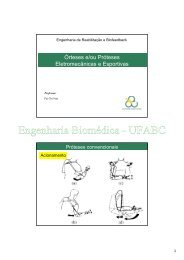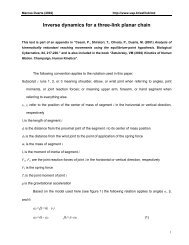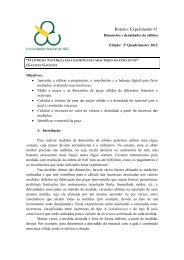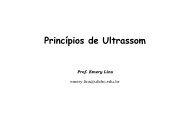Long-range correlations in human standing
Long-range correlations in human standing
Long-range correlations in human standing
- No tags were found...
You also want an ePaper? Increase the reach of your titles
YUMPU automatically turns print PDFs into web optimized ePapers that Google loves.
M. Duarte, V.M. Zatsiorsky / Physics Letters A 283 (2001) 124–128 127Fig. 2. DFA exponents α (a) and PSA exponents β (b). Th<strong>in</strong> l<strong>in</strong>esare the slopes for the ten subjects and both directions for lags greaterthan 10 s or frequencies smaller than 10 −1 Hz (<strong>in</strong>dicated by thedashed arrows). The median values are shown with thick l<strong>in</strong>es. Thel<strong>in</strong>es and values of the scal<strong>in</strong>g exponents for white and Browniannoise are shown for comparison (dashed l<strong>in</strong>es).the value α = 1for1/f noise, as shown <strong>in</strong> Fig. 2. Thereported <strong>range</strong> of the scal<strong>in</strong>g exponents for differentsubjects may suggest that the observed long-<strong>range</strong> <strong>correlations</strong>are not only a verification of the ubiquity of1/f noise <strong>in</strong> the nature but rather a phenomenon manifest<strong>in</strong>gdifferently across healthy adult subjects.To determ<strong>in</strong>e the statistical significance of theresults for long-<strong>range</strong> <strong>correlations</strong>, a surrogate testwas performed [17]. To this end, ten new samplepaths were created by randomly shuffl<strong>in</strong>g the orig<strong>in</strong>alsample path; the created sample paths had the samemean and variance as the orig<strong>in</strong>al ones but shouldhave no long-<strong>range</strong> <strong>correlations</strong>, <strong>in</strong>dicated by α = 0.5and β = 0. Compar<strong>in</strong>g the mean of the scal<strong>in</strong>gexponents for the set of shuffled data with the meanof the orig<strong>in</strong>al sample path, the difference betweenthe scal<strong>in</strong>g exponents was well above three standarddeviations, for each of the ten subjects and for bothmethods. Therefore, the hypothesis of long-<strong>range</strong><strong>correlations</strong> was accepted.To test if the observed long-<strong>range</strong> <strong>correlations</strong> werejust an effect of accumulated short-<strong>range</strong> <strong>correlations</strong>,the sample paths were divided <strong>in</strong>to w<strong>in</strong>dows of 10 slength and the data with<strong>in</strong> each w<strong>in</strong>dow were shuffledseparately. Now, the hypothesis was that the shuffleddata should still present long-<strong>range</strong> <strong>correlations</strong> if itreflected the global structure of the data. For eachof the ten subjects, the shuffled data still presentedlong-<strong>range</strong> <strong>correlations</strong> with scal<strong>in</strong>g exponents closeto the orig<strong>in</strong>al ones for both methods. The hypothesisof long-<strong>range</strong> <strong>correlations</strong> reflect<strong>in</strong>g a global structureof the data was therefore accepted aga<strong>in</strong>.A matter of concern was whether the long-<strong>range</strong><strong>correlations</strong> were created by the experimental setup,as electrical devices such as resistors <strong>in</strong> electricalcircuits were shown to exhibit long-<strong>range</strong> <strong>correlations</strong>of the form of 1/f noise [18]. The force plate usedto measure the applied forces and COP position isan electromechanical device based on stra<strong>in</strong> gauges.Indeed, the COP sample path of a dummy with similarweight as our subjects on the force plate producedthe expected 1/f noise with an α = 1.05. However,this 1/f noise behavior from the experimental setupcould be neglected because the magnitude of thefluctuations was about three orders smaller than theCOP fluctuations and the power spectra were aboutsix orders of magnitude smaller than the COP powerspectra.Fig. 2(a) shows the fitted l<strong>in</strong>e <strong>in</strong> the region of 10 sto 10 m<strong>in</strong> for the median data extended to the regionof 1 s and a fitted l<strong>in</strong>e for the data <strong>in</strong> the region ofup to 1 s. The <strong>in</strong>tersection of these two fits po<strong>in</strong>ted <strong>in</strong>Fig. 2(a) exemplifies the commented transition <strong>in</strong> theregion of 1 s of a persistent behavior (positive correlation<strong>in</strong> a short-<strong>range</strong> scale) to an anti-persistent behavior(negative correlation <strong>in</strong> a middle-<strong>range</strong> scale, up to10 s) of the COP displacement [3]. These results observed<strong>in</strong> all trials, corroborate the f<strong>in</strong>d<strong>in</strong>gs of Coll<strong>in</strong>sand De Luca [3] and extend the discovery of an antipersistentbehavior from up to 10 s to up to 10 m<strong>in</strong>.Note that <strong>in</strong> the present study, a more robust methodwas used (DFA versus classical random walk), the observationswere performed dur<strong>in</strong>g 30 m<strong>in</strong> long trials(as compared to 1 m<strong>in</strong> long trials used for the randomwalk analysis [3]), and a different task was stud-



